SimpleDateFormat线程不安全的5种解决方案!

作者 | 王磊
来源 | Java中文社群(ID:javacn666)
1.什么是线程不安全?
线程不安全也叫非线程安全,是指多线程执行中,程序的执行结果和预期的结果不符的情况就叫着线程不安全。
线程不安全的代码
SimpleDateFormat 就是一个典型的线程不安全事例,接下来我们动手来实现一下。首先我们先创建 10 个线程来格式化时间,时间格式化每次传递的待格式化时间都是不同的,所以程序如果正确执行将会打印 10 个不同的值,接下来我们来看具体的代码实现:
import java.text.SimpleDateFormat;
import java.util.Date;
import java.util.concurrent.ExecutorService;
import java.util.concurrent.Executors;
public class SimpleDateFormatExample {
// 创建 SimpleDateFormat 对象
private static SimpleDateFormat simpleDateFormat = new SimpleDateFormat("mm:ss");
public static void main(String[] args) {
// 创建线程池
ExecutorService threadPool = Executors.newFixedThreadPool(10);
// 执行 10 次时间格式化
for (int i = 0; i < 10; i++) {
int finalI = i;
// 线程池执行任务
threadPool.execute(new Runnable() {
@Override
public void run() {
// 创建时间对象
Date date = new Date(finalI * 1000);
// 执行时间格式化并打印结果
System.out.println(simpleDateFormat.format(date));
}
});
}
}
}
我们预期的正确结果是这样的(10 次打印的值都不同):
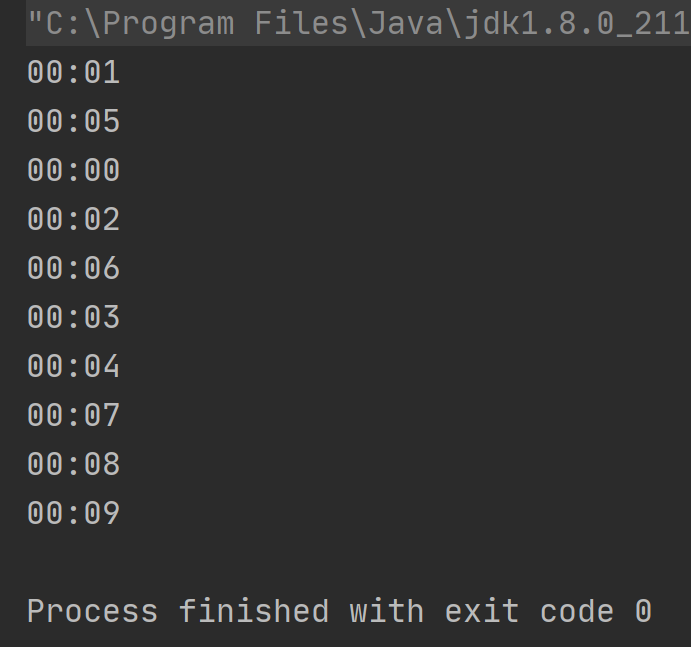
然而,以上程序的运行结果却是这样的:
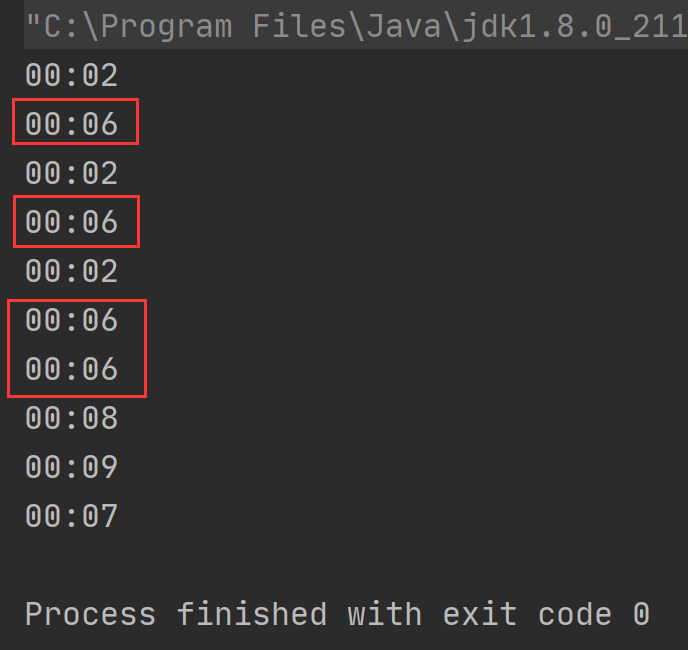
从上述结果可以看出,当在多线程中使用 SimpleDateFormat 进行时间格式化是线程不安全的。
2.解决方案
SimpleDateFormat 线程不安全的解决方案总共包含以下 5 种:
将 SimpleDateFormat定义为局部变量;使用 synchronized加锁执行;使用 Lock加锁执行(和解决方案 2 类似);使用 ThreadLocal;使用 JDK 8中提供的DateTimeFormat。
接下来我们分别来看每种解决方案的具体实现。
① SimpleDateFormat改为局部变量
将 SimpleDateFormat 定义为局部变量时,因为每个线程都是独享 SimpleDateFormat 对象的,相当于将多线程程序变成“单线程”程序了,所以不会有线程不安全的问题,具体实现代码如下:
import java.text.SimpleDateFormat;
import java.util.Date;
import java.util.concurrent.ExecutorService;
import java.util.concurrent.Executors;
public class SimpleDateFormatExample {
public static void main(String[] args) {
// 创建线程池
ExecutorService threadPool = Executors.newFixedThreadPool(10);
// 执行 10 次时间格式化
for (int i = 0; i < 10; i++) {
int finalI = i;
// 线程池执行任务
threadPool.execute(new Runnable() {
@Override
public void run() {
// 创建 SimpleDateFormat 对象
SimpleDateFormat simpleDateFormat = new SimpleDateFormat("mm:ss");
// 创建时间对象
Date date = new Date(finalI * 1000);
// 执行时间格式化并打印结果
System.out.println(simpleDateFormat.format(date));
}
});
}
// 任务执行完之后关闭线程池
threadPool.shutdown();
}
}
以上程序的执行结果为:

当打印的结果都不相同时,表示程序的执行是正确的,从上述结果可以看出,将 SimpleDateFormat 定义为局部变量之后,就可以成功的解决线程不安全问题了。
② 使用synchronized加锁
锁是解决线程不安全问题最常用的手段,接下来我们先用 synchronized 来加锁进行时间格式化,实现代码如下:
import java.text.SimpleDateFormat;
import java.util.Date;
import java.util.concurrent.ExecutorService;
import java.util.concurrent.Executors;
public class SimpleDateFormatExample2 {
// 创建 SimpleDateFormat 对象
private static SimpleDateFormat simpleDateFormat = new SimpleDateFormat("mm:ss");
public static void main(String[] args) {
// 创建线程池
ExecutorService threadPool = Executors.newFixedThreadPool(10);
// 执行 10 次时间格式化
for (int i = 0; i < 10; i++) {
int finalI = i;
// 线程池执行任务
threadPool.execute(new Runnable() {
@Override
public void run() {
// 创建时间对象
Date date = new Date(finalI * 1000);
// 定义格式化的结果
String result = null;
synchronized (simpleDateFormat) {
// 时间格式化
result = simpleDateFormat.format(date);
}
// 打印结果
System.out.println(result);
}
});
}
// 任务执行完之后关闭线程池
threadPool.shutdown();
}
}
以上程序的执行结果为:
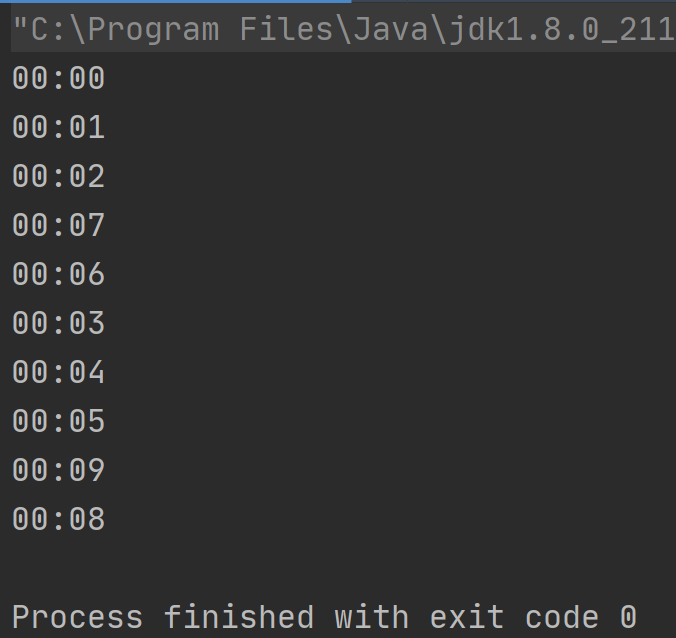
③ 使用Lock加锁
在 Java 语言中,锁的常用实现方式有两种,除了 synchronized 之外,还可以使用手动锁 Lock,接下来我们使用 Lock 来对线程不安全的代码进行改造,实现代码如下:
import java.text.SimpleDateFormat;
import java.util.Date;
import java.util.concurrent.ExecutorService;
import java.util.concurrent.Executors;
import java.util.concurrent.locks.Lock;
import java.util.concurrent.locks.ReentrantLock;
/**
* Lock 解决线程不安全问题
*/
public class SimpleDateFormatExample3 {
// 创建 SimpleDateFormat 对象
private static SimpleDateFormat simpleDateFormat = new SimpleDateFormat("mm:ss");
public static void main(String[] args) {
// 创建线程池
ExecutorService threadPool = Executors.newFixedThreadPool(10);
// 创建 Lock 锁
Lock lock = new ReentrantLock();
// 执行 10 次时间格式化
for (int i = 0; i < 10; i++) {
int finalI = i;
// 线程池执行任务
threadPool.execute(new Runnable() {
@Override
public void run() {
// 创建时间对象
Date date = new Date(finalI * 1000);
// 定义格式化的结果
String result = null;
// 加锁
lock.lock();
try {
// 时间格式化
result = simpleDateFormat.format(date);
} finally {
// 释放锁
lock.unlock();
}
// 打印结果
System.out.println(result);
}
});
}
// 任务执行完之后关闭线程池
threadPool.shutdown();
}
}
以上程序的执行结果为:

从上述代码可以看出,手动锁的写法相比于 synchronized 要繁琐一些。
④ 使用ThreadLocal
加锁方案虽然可以正确的解决线程不安全的问题,但同时也引入了新的问题,加锁会让程序进入排队执行的流程,从而一定程度的降低了程序的执行效率,如下图所示:
 那有没有一种方案既能解决线程不安全的问题,同时还可以避免排队执行呢?
那有没有一种方案既能解决线程不安全的问题,同时还可以避免排队执行呢?
答案是有的,可以考虑使用 ThreadLocal。ThreadLocal 翻译为中文是线程本地变量的意思,字如其人 ThreadLocal 就是用来创建线程的私有(本地)变量的,每个线程拥有自己的私有对象,这样就可以避免线程不安全的问题了,实现如下:
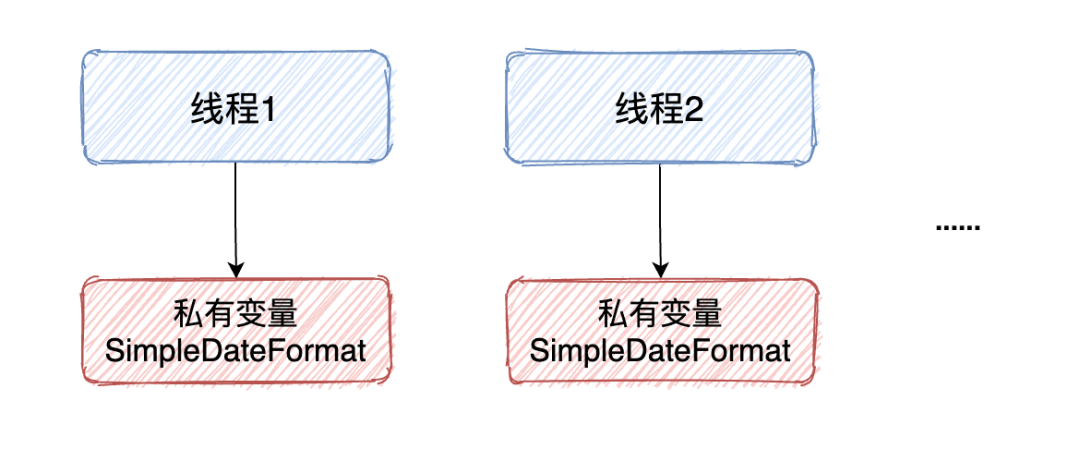
知道了实现方案之后,接下来我们使用具体的代码来演示一下 ThreadLocal 的使用,实现代码如下:
import java.text.SimpleDateFormat;
import java.util.Date;
import java.util.concurrent.ExecutorService;
import java.util.concurrent.Executors;
/**
* ThreadLocal 解决线程不安全问题
*/
public class SimpleDateFormatExample4 {
// 创建 ThreadLocal 对象,并设置默认值(new SimpleDateFormat)
private static ThreadLocal<SimpleDateFormat> threadLocal =
ThreadLocal.withInitial(() -> new SimpleDateFormat("mm:ss"));
public static void main(String[] args) {
// 创建线程池
ExecutorService threadPool = Executors.newFixedThreadPool(10);
// 执行 10 次时间格式化
for (int i = 0; i < 10; i++) {
int finalI = i;
// 线程池执行任务
threadPool.execute(new Runnable() {
@Override
public void run() {
// 创建时间对象
Date date = new Date(finalI * 1000);
// 格式化时间
String result = threadLocal.get().format(date);
// 打印结果
System.out.println(result);
}
});
}
// 任务执行完之后关闭线程池
threadPool.shutdown();
}
}
以上程序的执行结果为:
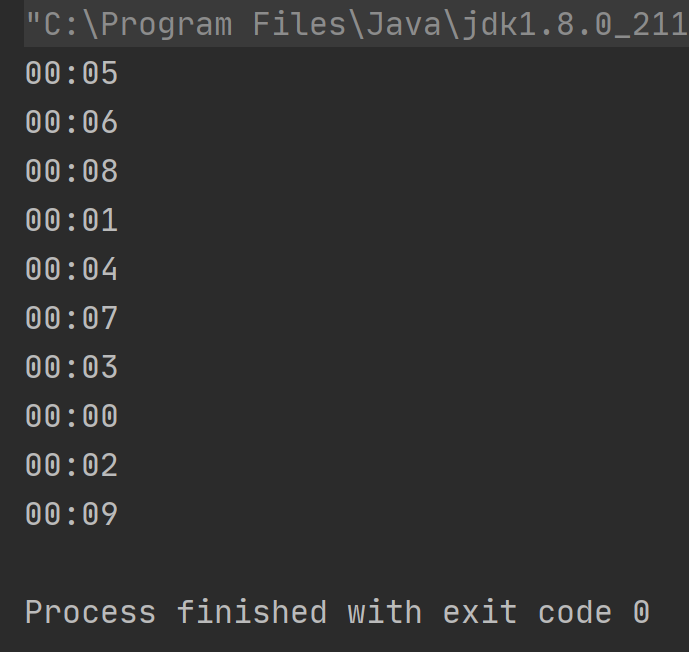
ThreadLocal和局部变量的区别
首先来说 ThreadLocal 不等于局部变量,这里的“局部变量”指的是像 2.1 示例代码中的局部变量, ThreadLocal 和局部变量最大的区别在于:ThreadLocal 属于线程的私有变量,如果使用的是线程池,那么 ThreadLocal 中的变量是可以重复使用的,而代码级别的局部变量,每次执行时都会创建新的局部变量,二者区别如下图所示:

更多关于 ThreadLocal 的内容,可以访问磊哥前面的文章《ThreadLocal不好用?那是你没用对!》。
⑤ 使用DateTimeFormatter
以上 4 种解决方案都是因为 SimpleDateFormat 是线程不安全的,所以我们需要加锁或者使用 ThreadLocal 来处理,然而,JDK 8 之后我们就有了新的选择,如果使用的是 JDK 8+ 版本,就可以直接使用 JDK 8 中新增的、安全的时间格式化工具类 DateTimeFormatter 来格式化时间了,接下来我们来具体实现一下。
使用 DateTimeFormatter 必须要配合 JDK 8 中新增的时间对象 LocalDateTime 来使用,因此在操作之前,我们可以先将 Date 对象转换成 LocalDateTime,然后再通过 DateTimeFormatter 来格式化时间,具体实现代码如下:
import java.time.LocalDateTime;
import java.time.ZoneId;
import java.time.format.DateTimeFormatter;
import java.util.Date;
import java.util.concurrent.ExecutorService;
import java.util.concurrent.Executors;
/**
* DateTimeFormatter 解决线程不安全问题
*/
public class SimpleDateFormatExample5 {
// 创建 DateTimeFormatter 对象
private static DateTimeFormatter dateTimeFormatter = DateTimeFormatter.ofPattern("mm:ss");
public static void main(String[] args) {
// 创建线程池
ExecutorService threadPool = Executors.newFixedThreadPool(10);
// 执行 10 次时间格式化
for (int i = 0; i < 10; i++) {
int finalI = i;
// 线程池执行任务
threadPool.execute(new Runnable() {
@Override
public void run() {
// 创建时间对象
Date date = new Date(finalI * 1000);
// 将 Date 转换成 JDK 8 中的时间类型 LocalDateTime
LocalDateTime localDateTime =
LocalDateTime.ofInstant(date.toInstant(), ZoneId.systemDefault());
// 时间格式化
String result = dateTimeFormatter.format(localDateTime);
// 打印结果
System.out.println(result);
}
});
}
// 任务执行完之后关闭线程池
threadPool.shutdown();
}
}
以上程序的执行结果为:
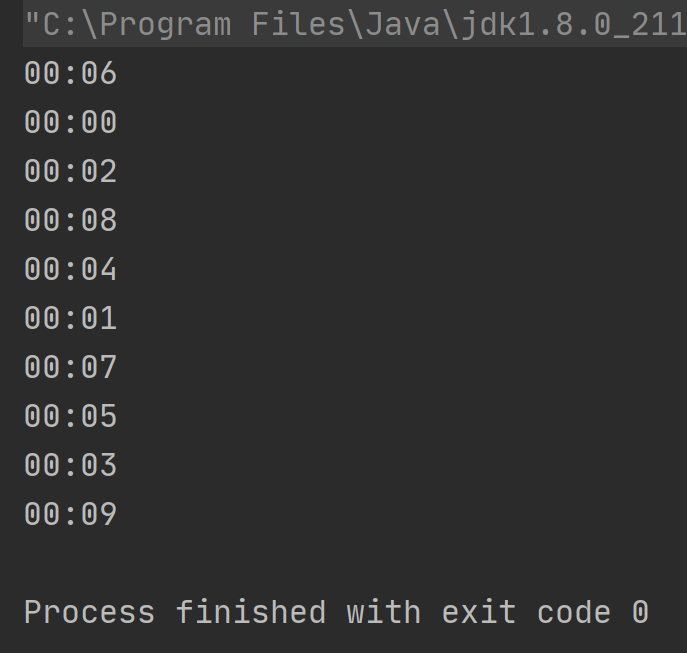
3.线程不安全原因分析
要了解 SimpleDateFormat 为什么是线程不安全的?我们需要查看并分析 SimpleDateFormat 的源码才行,那我们先从使用的方法 format 入手,源码如下:
private StringBuffer format(Date date, StringBuffer toAppendTo,
FieldDelegate delegate) {
// 注意此行代码
calendar.setTime(date);
boolean useDateFormatSymbols = useDateFormatSymbols();
for (int i = 0; i < compiledPattern.length; ) {
int tag = compiledPattern[i] >>> 8;
int count = compiledPattern[i++] & 0xff;
if (count == 255) {
count = compiledPattern[i++] << 16;
count |= compiledPattern[i++];
}
switch (tag) {
case TAG_QUOTE_ASCII_CHAR:
toAppendTo.append((char)count);
break;
case TAG_QUOTE_CHARS:
toAppendTo.append(compiledPattern, i, count);
i += count;
break;
default:
subFormat(tag, count, delegate, toAppendTo, useDateFormatSymbols);
break;
}
}
return toAppendTo;
}
也许是好运使然,没想到刚开始分析第一个方法就找到了线程不安全的问题所在。
从上述源码可以看出,在执行 SimpleDateFormat.format 方法时,会使用 calendar.setTime 方法将输入的时间进行转换,那么我们想象一下这样的场景:
线程 1 执行了 calendar.setTime(date)方法,将用户输入的时间转换成了后面格式化时所需要的时间;线程 1 暂停执行,线程 2 得到 CPU时间片开始执行;线程 2 执行了 calendar.setTime(date)方法,对时间进行了修改;线程 2 暂停执行,线程 1 得出 CPU时间片继续执行,因为线程 1 和线程 2 使用的是同一对象,而时间已经被线程 2 修改了,所以此时当线程 1 继续执行的时候就会出现线程安全的问题了。
正常的情况下,程序的执行是这样的:
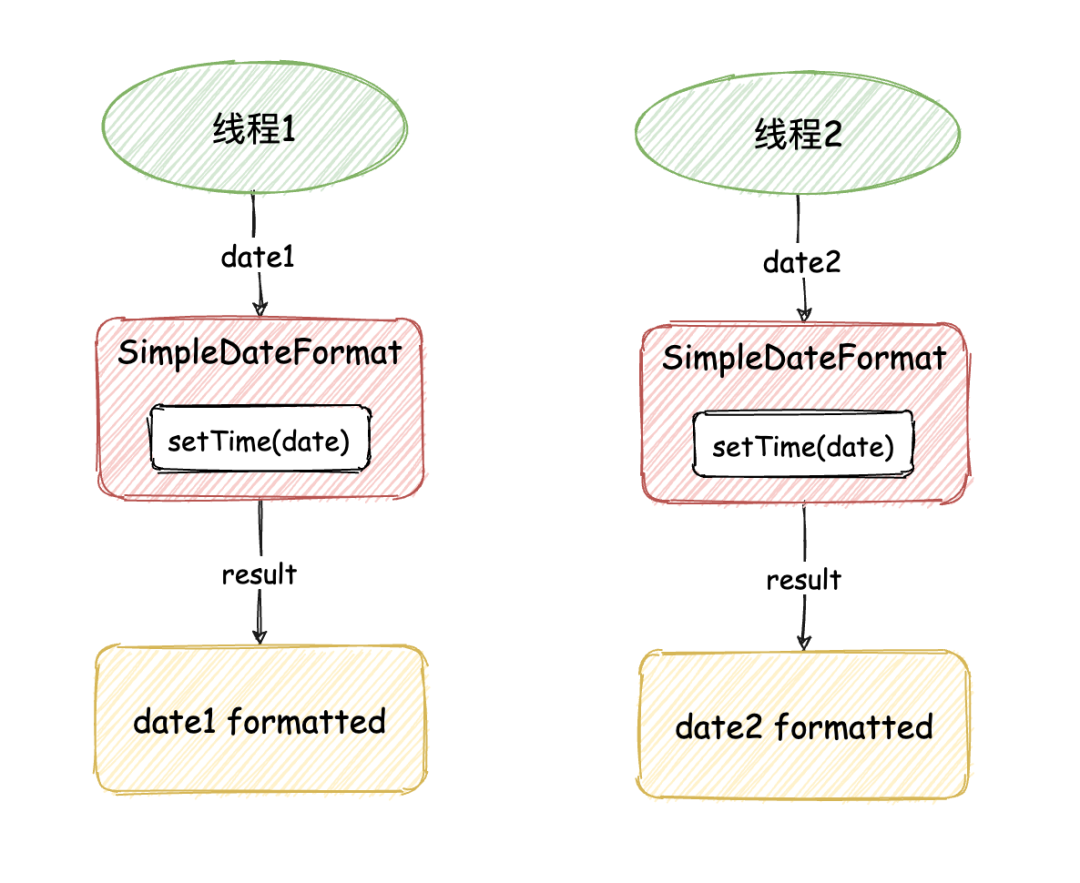
非线程安全的执行流程是这样的:
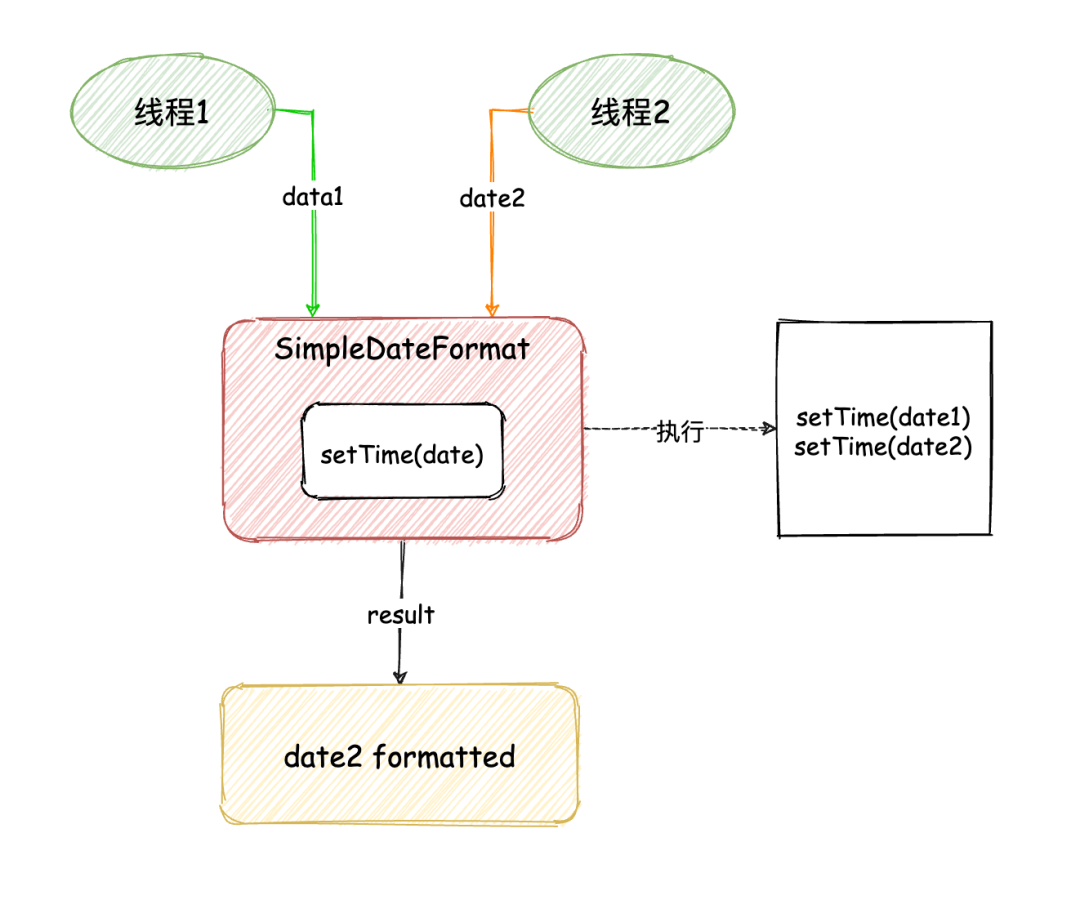 在多线程执行的情况下,线程 1 的
在多线程执行的情况下,线程 1 的 date1 和线程 2 的 date2,因为执行顺序的问题,最终都被格式化成 date2 formatted,而非线程 1 date1 formatted 和线程 2 date2 formatted,这样就会导致线程不安全的问题。
4.各方案优缺点总结
如果使用的是 JDK 8+ 版本,可以直接使用线程安全的 DateTimeFormatter 来进行时间格式化,如果使用的 JDK 8 以下版本或者改造老的 SimpleDateFormat 代码,可以考虑使用 synchronized 或 ThreadLocal 来解决线程不安全的问题。因为实现方案 1 局部变量的解决方案,每次执行的时候都会创建新的对象,因此不推荐使用。synchronized 的实现比较简单,而使用 ThreadLocal 可以避免加锁排队执行的问题。

往期推荐

ThreadLocal不好用?那是你没用对!

Semaphore自白:限流器用我就对了!

额!Java中用户线程和守护线程区别这么大?
